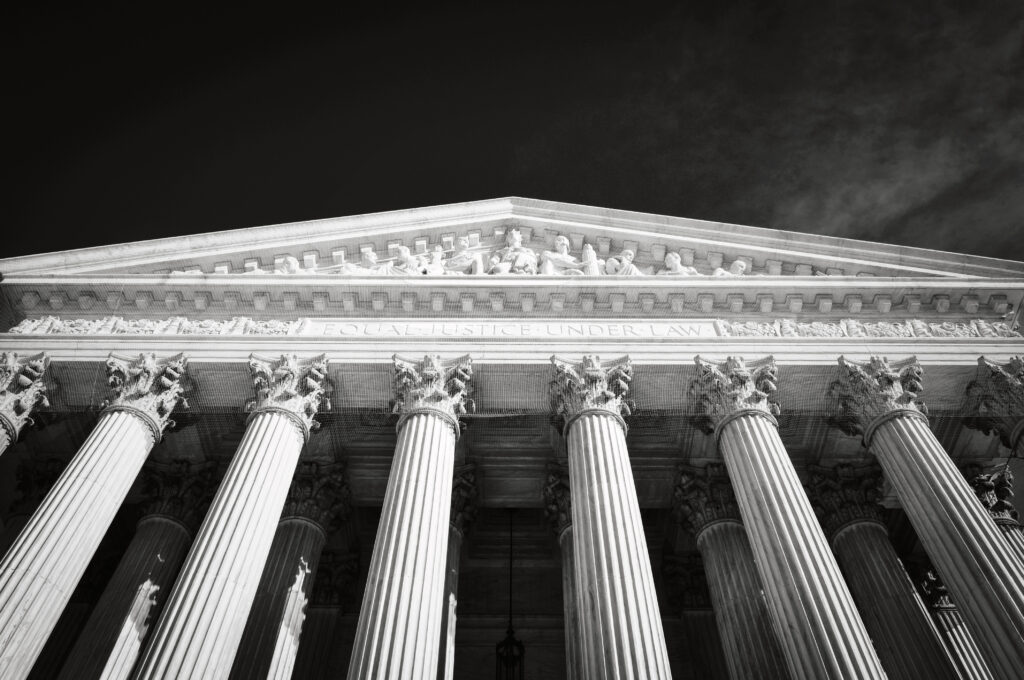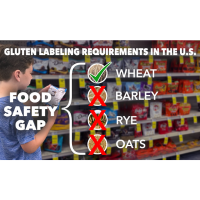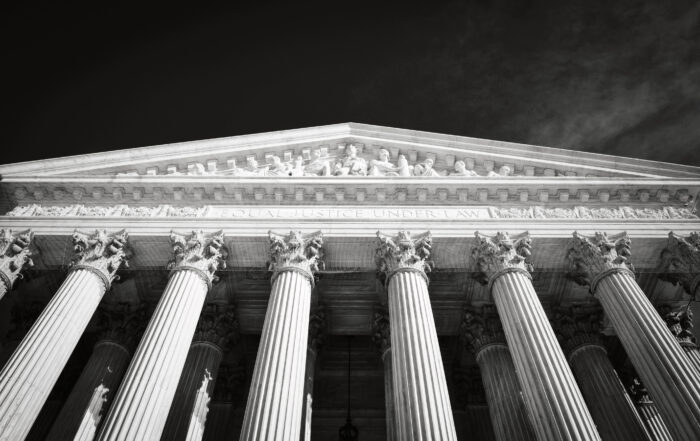
Chevron Deference on the Brink: Small Fish May Mean Big Changes For FDA
By Chad Landmon, Aaron Savit & Ian Swan
Since 1984, courts have frequently invoked the Chevron doctrine to grant broad discretion to federal agencies to interpret statutes.[1] Such broad application of Chevron, however, has fallen out of favor with many jurists, including several of the most recently appointed Supreme Court Justices.[2] Moreover, the Supreme Court appeared to eschew Chevron in more recent cases, such as American Hospital Ass’n v. Becerra.[3] Other federal courts have followed suit and given less weight to Chevron deference. Now, the Court is considering two related cases, Loper Bright Enterprises v. Raimondo and Relentless v. Department of Commerce, that may narrow Chevron deference or overturn it entirely.
If the Court’s decision in Loper Bright and Relentless weakens Chevron deference, a flood of challenges to FDA’s administrative decisions may ensue.
I. The Chevron Framework
The two-step Chevron test provides a framework for reviewing statutory interpretations by federal agencies. First, a court must determine whether “Congress has directly spoken to the precise question at issue” because “[i]f the intent of Congress is clear . . . the court, as well as the agency, must give effect to the unambiguously expressed intent of Congress.”[4] Second, if Congress has not directly addressed the question at issue, the court then determines whether the “agency’s answer is based on a permissible construction of the statute.”[5]
Under the Federal Food, Drug, and Cosmetic Act (FDCA), FDA has broad power to develop advisory regulations, which have the force of law provided they undergo the notice and comment rulemaking process.[6] But, FDA often treats certain nonbinding guidances and policy statements as having the same force of law.[7] FDA thus “occasionally cross[es] a statutory or constitutional line when necessary to accomplish some valuable end.”[8] Chevron has been used to further bolster FDA’s rulemaking power by requiring that courts defer to any reasonable agency interpretation of a statute that is deemed ambiguous.
The Administrative Procedure Act (APA) allows federal courts to set aside any agency action that is “arbitrary, capricious, an abuse of discretion, or otherwise not in accordance with the law.”[9] Although the APA urges some degree of deference to agencies, judges are given the last word on incorrect agency interpretations of law.[10] Where a statute is ambiguous, Chevron has been applied by some courts to accept any reasonable agency interpretation—even when there are better, more reasonable constructions[11] or the interpretation first appeared during litigation.[12] Courts have consequently invoked Chevron to bestow agencies with broad interpretive power when a statute is silent on an issue. Chevron deference has thus allowed agencies to explore the limits of their authority, knowing that such efforts are rarely curtailed by the courts.[13]
II. Today’s SCOTUS on Chevron
The Supreme Court has signaled that the days of Chevron may be numbered. Several Justices have indicated a desire to narrow or eliminate Chevron deference. For example, Justice Thomas characterized the doctrine as a violation of the separation of powers.[14] Chief Justice Roberts, by constrast, has endorsed a gatekeeping “step zero,” in which a court considers whether Congress gave an agency authority to make rules carrying the force of law before moving on to the traditional two-step deference test.[15] The Chief Justice’s high bar for “step zero,” under which courts would reach Chevron Step One “only if Congress has delegated authority to definitely interpret a particular ambiguity in a particular manner[,]” suggests that he favors restricting administrative deference.[16] Justice Alito has been willing to apply Chevron while it remains good law[17] and expressed reluctance to implicitly phase out the doctrine through non-use.[18] But Justice Alito has also criticized Chevron deference as “a massive shift of lawmaking from the elected representatives of the people to unelected bureaucrats.”[19]
Newer Justices have deepened the ranks of the Court’s Chevron skeptics. For example, Justice Kavanaugh shares Alito’s criticism[20] and favors a more robust Chevron Step One.[21] Justice Gorsuch has argued that Chevron deserves second-rate precedential consideration because it is a difficult-to-administer, procedural rule.[22] And he recently stated that Chevron “deserves a tombstone no one can miss.”[23] Justice Barrett’s position on Chevron is less clear,[24] but her recent endorsement of the “major questions doctrine” suggests she may support narrowing Chevron.[25] Under the major questions doctrine, courts do not consider “statutory opacity” to be a delegation of Congress’ legislative authority when an interpretation implicates a major question of social, economic, or political policy.[26]
Even the Court’s more liberal Justices have expressed mixed views about Chevron. To be sure, Justices Kagan and Sotomayor both support deference to agency interpretations of law in some circumstances.[27] But, both Justices joined the majority in Kisor v. Wilkie, which narrowed judicial deference to agency interpretations of their own regulations.[28] Justice Kagan wrote that “before concluding that a rule is genuinely ambiguous, a court must exhaust all the ‘traditional tools’ of construction.”[29] In multiple cases post-Kisor, Justices Kagan and Sotomayor have declined deference to administrative interpretations, instead finding statutes unambiguous after applying traditional statutory interpretation tools.[30] Justices Kagan and Sotomayor could thus potentially join an opinion narrowing Chevron.
Justice Jackson has committed to “apply[ing] faithfully all binding precedents . . . including any precedent pertaining to the level of deference that should be afforded to agencies.”[31] One analysis found that, prior to her time on the Court, then-Judge Jackson “show[ed] no inclination to challenge long-standing doctrines like Chevron.”[32] It nevertheless noted that “[s]he does appear to apply Chevron actively . . . and cannot be accused of using it as a ‘rubber stamp’ for agency action.”[33] Overall, there is no indication that Justice Jackson would favor a significant change to the doctrine.
A majority of the Supreme Court thus appears willing to reevaluate the scope of Chevron deference. So, what will that look like and what impact will it have on FDA and other federal agencies?
III. An Inflection Point for Chevron
For many observers, American Hospital Ass’n v. Becerra was a signal from the Supreme Court that Chevron’s days were numbered. In that case, the statute required the U.S. Department of Health and Human Services (HHS) to conduct a hospital survey before it changed reimbursement rates for different groups of hospitals. But HHS did not do so, and chose instead to decrease reimbursement rates for certain hospitals without the requisite survey. Ultimately, the Court overturned HHS’s interpretation, but the opinion was notable for what it omitted—the Court did not provide a single reference to Chevron, nor did it conduct a two-step analysis. Instead, the Court applied “the traditional tools of statutory interpretation” to analyze the text, structure, and purpose of the statute.[34] By omitting Chevron in an important case involving administrative deference, the Court appeared to distance itself from the doctrine.
Since then, American Hospital Ass’n has been frequently cited in cases challenging administrative action. In United States v. Texas, for example, the Supreme Court even cited its own opinion in American Hospital Ass’n to support the idea that it is “routine[] and appropriate[] [to] decide[] justiciable cases involving statutory requirements or prohibitions on the Executive.”[35] Other federal courts have also referenced American Hospital Ass’n, including the U.S. District Court for D.C. and the D.C. Circuit, both of which handle a large share of administrative challenges.[36]
Other federal appellate courts have increasingly left Chevron by the wayside. For example, the Fifth Circuit has noted that “there is no need to go through [the Chevron] steps when a statute unambiguously forecloses an agency’s position.”[37] The Ninth Circuit likewise noted that “the future of the Chevron deference doctrine has been called into question.”[38] A range of federal courts have thus signaled their willingness to limit the use of Chevron significantly.
IV. The Cases Before SCOTUS
The two cases before the Supreme Court will likely decide the future of Chevron deference. On January 17, 2024, the Supreme Court heard oral arguments in Loper Bright and Relentless.
Loper Bright involves a challenge to regulations from the National Marine Fisheries Service (NMFS) requiring fishing vessel owners to pay per diem fees for compliance officers that vessels must carry to monitor compliance with fisheries rules.[39] On appeal, the D.C. Circuit employed a traditional Chevron analysis, identifying potential ambiguity in the statute (Step One) before applying Step Two and holding that “the Service’s interpretation of the [statute] as authorizing additional industry-funded monitoring programs is reasonable.”[40] The Supreme Court granted certiorari in Loper Bright on May 1, 2023 to decide whether it “should overrule Chevron or at least clarify that statutory silence concerning controversial powers expressly but narrowly granted elsewhere in the statute does not constitute an ambiguity requiring deference to the agency.”[41]
Relentless involves another challenge to an NMFS rule requiring that herring fishing companies pay for monitors to accompany each vessel. On appeal, the First Circuit departed from the typical Chevron analysis. In upholding NMFS’s interpretation of the relevant statute, the court noted that it “need not decide whether [to] classify this conclusion as a product of Chevron step one or step two.”[42] On October 13, 2023, the Court granted certiorari on the same question as in Loper Bright, consolidating the two cases.
V. Oral Arguments
When the Supreme Court heard oral arguments for both cases on January 17, 2024, the Justices’ questions telegraphed a likely change to the standard for agency deference. The Court’s conservative wing was largely critical of Chevron deference, whereas the more liberal Justices defended its utility. But across the board, all Justices seemed to think that Chevron needs a significant overhaul, if it is not overturned altogether.
The more conservative Justices appeared unpersuaded by the Solicitor General’s defense of Chevron, questioning the doctrine’s constitutional basis and its ability to parse between questions of law and policy. Justice Gorsuch attacked Chevron’s underlying presumption that any statutory ambiguity implies a congressional delegation of interpretive authority, calling it a “fiction.”[43] Justice Kavanaugh expressed concern with the doctrine’s effect on the separation of powers, particularly how it shifts power from Congress to the Executive branch.[44] He and Justice Alito questioned the justification for treating certain questions as policy matters under Chevron, when those same issues would be resolved as questions of law absent an Executive agency.[45] The more conservative Justices thus seemed unconvinced that Chevron deference properly respects congressional intent or aligns with principles of statutory interpretation.
Justices Gorsuch and Kavanaugh also asserted that Chevron deference decreases stability and uniformity in the law by delegating authority to Executive agencies. According to them, Chevron deference creates a “recipe for anti-reliance” that causes “shocks to the system every four to eight years when a new administration comes in” and changes agencies’ policy goals.[46] As evidence that Chevron fails to standardize results in real cases, Justice Gorsuch stated that “some judges claim never to have found an ambiguity [in a statute] and other equally excellent . . . judges have said they find them all the time.”[47]
Questions from the Court’s more liberal Justices expressed an opposing view regarding separation of powers and cautioned against vesting the judiciary with powers that Congress had properly delegated to Executive agencies.[48] Justice Jackson pointedly noted that, absent Chevron, unelected judges could become “uber-legislators,” able to override the will of Congress under the guise of judicial interpretive power.[49] Justices Kagan and Sotomayor also stressed the importance of stare decisis, given the numerous cases that have relied on Chevron to validate agency interpretations.[50]
Justices Kagan and Sotomayor also defended the rationale behind Chevron, i.e., in cases where there is more than one reasonable interpretation of a statute, the issue should be decided by field-specific experts rather than judges.[51] The Court’s more liberal Justices thus defended Chevron’s constitutional underpinnings and real-life applicability.
Despite their defense of Chevron, both the liberal wing of the Court and the Solicitor General recognized that Chevron needs to be reworked. Justices Sotomayor and Jackson acknowledged that there was major disagreement about the definition of “ambiguity” as used in the first step of Chevron.[52] At one point, the Solicitor General suggested that the Court could take a number of steps to overhaul the Chevron analysis, including: 1) “reemphasiz[ing] the rigor of the [Chevron] step one analysis,” 2) assessing whether an agency has transgressed the outer boundaries of a statute at Step Two, 3) emphasizing that Chevron only applies where Congress has empowered an agency to speak with the force of law, and 4) stressing the importance of looking at statutory indications that Chevron deference is not meant to apply.[53] Even the more pro-Chevron Justices, and indeed the Executive branch itself, seem to concede that Chevron needs a more clearly defined Step One analysis before a court defers to an agency interpretation.
Although the Justices’ criticisms of Chevron generally correlated with their political views, Justice Barrett’s questions indicated that she could be more open to reworking Chevron, even though her more conservative colleagues may be inclined to abandon it altogether. Justice Barrett joined Justice Kagan in questioning the strict divide between questions of law and policy, asking whether judges were fit to decide whether a product was a “dietary supplement” or a “drug.”[54] She also joined Justice Kagan to ask what “Kisorizing” Chevron[55] might look like, allowing the Solicitor General to lay out the government’s vision of how to modify, rather than eliminate, the Chevron doctrine. Predicting a “flood of litigation” if the Court overturns Chevron,[56] Justice Barrett echoed the government’s concern about litigants “com[ing] out of the woodwork” to challenge agency interpretations that were upheld under Chevron.[57]
The Justices’ questions touched on another issue of particular relevance to food and drug law. Justice Gorsuch criticized agencies for using informal adjudications and rulemaking, as well as interpretive rules, to essentially make law without providing for public notice or comment.[58] Of course, FDA frequently resolves thorny issues through the issuance of guidances or letter decisions on particular matters.[59] These are not formal regulations, subject to notice and comment. FDA’s use of such informal rulemaking may thus come under greater scrutiny.
VI. Where Does this Leave Us?
The questioning in Loper Bright and Relentless confirmed that the days of Chevron, as we know it, may be numbered. The writing on the wall indicates that the Court is poised to narrow Chevron deference significantly or replace it entirely. Regulated industry and public interest groups may benefit from a more even playing field in litigation against FDA and other agencies. In the short term, this may result in Justice Barrett’s predicted “flood of litigation” challenging how agencies read and apply the law. Of course, only time will tell whether the judiciary in a post-Chevron world will more actively evaluate the scientific determinations impacting FDA’s health and safety decisions, as Justice Kagan seems to fear. At a minimum, however, a scaling back of Chevron deference will create more uncertainty for FDA and the companies it regulates.
Absent the litigation advantage of Chevron deference, agencies may also become more responsive to challenges to their interpretations. As such, regulated industry may find even greater benefit from proactive advocacy before initiating litigation against an agency.
We will learn shortly from the Supreme Court whether Chevron deference will have any life left. But, if the last days of Chevron are upon us, then FDA and the industries it regulates may have to buckle up for a bumpy ride.
[1] Chevron U.S.A. Inc. v. Nat. Res. Def. Council, Inc., 104 S. Ct. 2778 (1984).
[2] Zach Schonfeld, Chevron Case: Supreme Court Could Take a Sledgehammer to Agency Power, The Hill (May 4, 2023), https://thehill.com/regulation/court-battles/3986610-chevron-case-supreme-court-could-take-sledgehammer-to-agency-power/ (asserting that, after granting certiorari in Loper Bright, “[t]he Supreme Court’s conservative majority may soon have a chance to dramatically limit the power of federal regulators”).
[3] Am. Hosp. Ass’n v. Becerra, 142 S. Ct. 1896 (2022).
[4] Chevron, 104 S. Ct. at 2781.
[5] Id. at 2781–82.
[6] See 21 U.S.C. § 371(a); Nat’l Ass’n of Pharm. Mfrs. v. FDA, 637 F.2d 877, 887 (2d Cir. 1981) (holding that regulations have the force of law as long as they undergo notice and comment process).
[7] See, e.g., Am. Acad. of Pediatrics v. FDA, 379 F. Supp. 3d 461, 497 (D. Md. 2019) (vacating FDA guidance that “include[d] commands, requirements, and order[s]” and effectively amended the Tobacco Control Act without being subject to public notice and comment).
[8] Lars Noah, The Little Agency That Could (Act with Indifference to Constitutional and Statutory Strictures), 93 Cornell L. Rev. 901, 903 (2008); see also United States v. Parkinson, 240 F.2d 918, 921 (9th Cir. 1956) (“The record of the past few decades is replete with examples of the tendency of executive agencies to expand their field of operations . . . .”).
[9] 5 U.S.C. § 706(2)(A).
[10] Id.; Ronald A. Cass, Auer Deference: Doubling Down on Delegation’s Defects, 87 Fordham L. Rev. 531, 537–38 (2018).
[11] See Nat’l Cable & Telecomms. Ass’n v. Brand X Internet Servs., 125 S. Ct. 2688, 2699 (2005) (“Chevron requires a federal court to accept the agency’s [reasonable] construction of the statute, even if the agency’s reading differs from what the court believes is the best statutory interpretation.”).
[12] Ranbaxy Lab’ys, Ltd. v. Burwell, 82 F. Supp. 3d 159, 182 (D.D.C. 2015).
[13] See Kent Barnett & Christopher J. Walker, Chevron in the Circuit Courts, 116 Mich. L. Rev. 1, 6 (2017) (finding that, when considering Step Two of Chevron analysis, circuit courts deferred to agency interpretations 93.8% of the time).
[14] See Michigan v. EPA, 135 S. Ct. 2699, 2712 (2015) (Thomas, J., concurring) (arguing that Chevron “wrests from Courts the ultimate interpretative authority to ‘say what the law is,’ . . . and hands it over to the Executive. . . . Such a transfer is in tension with Article III’s Vesting Clause, which vests the judicial power exclusively in Article III courts, not administrative agencies”); Cuozzo Speed Techs., LLC v. Lee, 136 S. Ct. 2131, 2148 (2016) (Thomas, J., concurring) (noting that Chevron rests on the “fiction that ambiguity in a statutory term is best construed as an implicit delegation of power to an administrative agency to determine the bounds of the law”).
[15] See City of Arlington v. FCC, 133 S. Ct. 1863, 1877 (2013) (Roberts, C.J., dissenting).
[16] Id. at 1883.
[17] See Pereira v. Sessions, 138 S. Ct. 2105, 2121 (2018) (Alito, J., dissenting).
[18] See David B. Rivkin Jr. & James Taranto, Samuel Alito, the Supreme Court’s Plain-Spoken Defender, Wall St. J. (June 28, 2023), https://www.wsj.com/articles/samuel-alito-the-supreme-courts-plain-spoken-defender-precedent-ethics-originalism-5e3e9a7.
[19] Justice Samuel Alito’s Remarks at the Claremont Institute, 2/11/2017, SCOTUS Map (Feb. 22, 2017), https://www.scotusmap.com/posts/2.
[20] Brett M. Kavanaugh, Fixing Statutory Interpretation, 129 Harv. L. Rev. 2118, 2150–51 (2016) (denouncing Chevron deference as a “judicially orchestrated shift of power from Congress to the Executive Branch” and arguing that it is an “atextual invention” that is difficult to apply, and that it invites agencies to push the legal envelope).
[21] Denise Wagner, ND Law Review Symposium Features Q&A with Supreme Court Justice Brett Kavanaugh, Univ. Notre Dame (Jan. 26, 2023), https://law.nd.edu/news-events/news/2023-law-review-federal-courts-keynote-justice-brett-kavanaugh/ (Kavanaugh endorsing Chevron’s footnote 9, which instructs judges to apply all of the traditional tools of statutory interpretation in an attempt to resolve ambiguity, and noting that applying the traditional tools often yields an answer that requires no further analysis).
[22] See Gutierrez-Brizuela v. Lynch, 834 F.3d 1142, 1157–58 (10th Cir. 2016).
[23] Buffington v. McDonough, 143 S. Ct. 14, 22 (2022).
[24] See Nomination of Amy Coney Barrett: Responses to Questions from S. Judiciary Comm., 116th Cong. 3–4 (2020) (then-Judge Barrett stating that Chevron is precedent, but not “super precedent” and Sen. Klobuchar noting an article in which Barrett suggested that courts should have “humility about the capacity of judges to evaluate the soundness of scientific and economic claims”); Nicholas Bagley, Justices Mull Chevron and Voice Skepticism of Medicare’s Rate Cut for Hospital Drugs, SCOTUSBlog (Nov. 30, 2021), https://www.scotusblog.com/2021/11/justices-mull-chevron-and-voice-skepticism-of-medicares-rate-cut-for-hospital-drugs/ (noting that Justice Barrett questioned during the American Hospital Ass’n oral argument whether the ambiguity in the statute might raise “the classic problem of statutory interpretation that a court should resolve, as opposed to one that reflects some sort of delegation to the agency”).
[25] See Biden v. Nebraska, 143 S. Ct. 2355, 2376, 2384 (2023) (describing major questions doctrine as “a tool for discerning – not departing from – the text’s most natural interpretation” and applying it).
[26] See FDA v. Brown & Williamson Tobacco Corp., 529 U.S. 120, 133 (2000).
[27] West Virginia v. EPA, 142 S. Ct. 2587, 2642 (Kagan, J., dissenting) (finding that “[m]embers of Congress often don’t know enough—and know they don’t know enough—to regulate sensibly on an issue. . . . [T]hey rely . . . on people with greater expertise and experience. Those people are found in agencies.”); Transcript of Oral Argument at 24–25, Kisor v. Wilkie, 139 S. Ct. 2400 (2019) (No. 18-15) (Justice Sotomayor arguing that Auer deference is based on agency expertise and adding “regulated parties should know where to start, and the best people who can tell them is the agency who’s responsible to the public for having sound . . . or reasonable interpretations”).
[28] See Kisor v. Wilkie, 139 S. Ct. at 2424.
[29] Id. at 2404 (citing Chevron, 104 S. Ct. at 2778).
[30] See Becerra v. Empire Health Found., for Valley Hosp. Med. Ctr., 142 S. Ct. 2354, 2362–68 (2022) (Justice Kagan finding that the relevant statute had a clear meaning without referencing Chevron, which coincided with the agency’s interpretation of the statute); Pereira v. Sessions, 138 S. Ct. at 2113 (Justice Sotomayor noting that “the Court need not resort to Chevron deference, as some lower courts have done, for Congress has supplied a clear and unambiguous answer . . . .”).
[31] See Nomination of Ketanji Brown Jackson: Responses to Questions from S. Judiciary Comm., 117th Cong. 77 (2022) (stating that Justice Jackson had previously applied Chevron and would continue to do so as long as it remains precedential).
[32] Analysis of President Biden’s Potential Nominees to the U.S. Supreme Court, New C.L. All. (Feb. 10, 2022), https://nclalegal.org/wp-content/uploads/2022/02/NCLA-SCOTUS-Report-February-2022.pdf.
[33] Id.
[34] Am. Hosp. Ass’n, 142 S. Ct. at 1904–06.
[35] United States v. Texas, 143 S. Ct. 1964, 1974–75 (2023) (citing Am. Hosp. Ass’n, 142 S. Ct. at 1903–06).
[36] See, e.g., Ascendium Educ. Sols., Inc. v. Cardona, 78 F.4th 470, 479 (D.C. Cir. 2023) (beginning analysis of agency action with “traditional tools of statutory interpretation: text, context, structure, and purpose” and citing Am. Hosp. Ass’n); Guedes v. ATF, 45 F.4th 306, 313 (D.C. Cir. 2022) (“Ultimately, we need not wrestle with the Chevron framework here. Rather, the parties have asked us to dispense with the Chevron framework, and in this circumstance, we think it is appropriate to do so.”); Garvey v. Admin. Rev. Bd., U.S. Dep’t of Lab., 56 F.4th 110, 121 (D.C. Cir. 2022) (“We need not decide any Chevron issue in this case. The Supreme Court has made it clear that ‘Chevron deference does not apply where the statute is clear.’”).
[37] BP Am., Inc. v. FERC, 52 F.4th 204, 217 (5th Cir. 2022).
[38] Diaz-Rodriguez v. Garland, 55 F.4th 697, 728 (9th Cir. 2022).
[39] Loper Bright Enters. v. Raimondo, 544 F. Supp. 3d 82, 96–98 (D.D.C. 2021), aff’d, 45 F.4th 359 (D.C. Cir. 2022).
[40] Loper Bright Enters., 45 F.4th at 369.
[41] Brief for Petitioner at i, Loper Bright Enters. v. Raimondo, 143 S. Ct. 2429 (2022) (No. 21-5166).
[42] Relentless, Inc. v. U.S. Dep’t of Com., 62 F.4th 621, 634 (1st Cir. 2023).
[43] Transcript of Oral Argument, supra note 41, at 53–54.
[44] Transcript of Oral Argument at 140–41, Relentless, Inc. v. U.S. Dep’t of Com., 144 S. Ct. 325 (2023) (No. 22-1219).
[45] Id. at 114, 116, 135–36.
[46] Id. at 93–94, 96.
[47] Id. at 88.
[48] Id. at 25, 27, 45, 65–66.
[49] Id. at 69–70, 99.
[50] Id. at 38; 117–18; Transcript of Oral Argument, supra note 41, at 34–36 (expressing concern about “blow[ing] up two “doctrine[s] of humility” by overturning Chevron despite stare decisis).
[51] See, e.g., Transcript of Oral Argument, supra note 44, at 17–18.
[52] Id. at 17, 70, 147–48.
[53] Transcript of Oral Argument, supra note 41, at 81–83.
[54] Transcript of Oral Argument, supra note 44, at 30–31.
[55] In Kisor, the Court held that, before applying Auer deference, courts must find a regulation “genuinely ambiguous, even after resort[ing] to all the standard tools of interpretation[,]” effectively raising the bar for deference. Kisor, 139 S. Ct. at 2414. Thus, “Kisorizing” Chevron would place a greater emphasis on the Step One ambiguity inquiry and require judges to engage in more rigorous statutory interpretation before deferring.
[56] Transcript of Oral Argument, supra note 44, at 59–60.
[57] Id. at 80–81.
[58] Transcript of Oral Argument, supra note 41, at 73.
[59] Am. Acad. of Pediatrics, 379 F. Supp. 3d at 497.
Update Magazine
Spring 2024



 IAN SWAN is an associate in Axinn’s IP and FDA Practice Groups.
IAN SWAN is an associate in Axinn’s IP and FDA Practice Groups.





